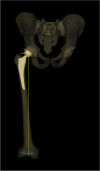Assessing component orientation of total hip arthroplasty using the low-dose bi-planar radiographs
- PMID: 36154920
- PMCID: PMC9511787
- DOI: 10.1186/s12891-022-05835-3
Assessing component orientation of total hip arthroplasty using the low-dose bi-planar radiographs
Abstract
Background: Three-dimensional computed tomography (3D CT) reconstruction is the reference standard for measuring component orientation. However, functional cup orientation in standing position is preferable compared with supine position. The low-dose bi-planar radiographs can be used to analyze standing cup component orientation. We aimed to assess the validity and reliability of the component orientation using the low-dose bi-planar radiographs compared with the 3D CT reconstruction, and explore the differences between the functional cup orientation in standing radiographs and supine CT scans.
Methods: A retrospective study, including 44 patients (50 hips) with total hip arthroplasty (THA), was conducted. CT scans were taken 1 week after surgery and the low-dose bi-planar radiographs were taken in the follow-up 6 weeks later. Component orientation measurement was performed using the anterior pelvic plane and the radiographic coronal plane as reference, respectively.
Results: The study showed no significant difference in cup anteversion (p = 0.160), cup inclination (p = 0.486), and stem anteversion (p = 0.219) measured by the low-dose bi-planar radiographs and 3D reconstruction. The differences calculated by the Bland-Altman analysis ranged from - 0.4° to 0.6° for the three measured angles. However, the mean absolute error was 4.76 ± 1.07° for functional anteversion (p = 0.035) and 4.02 ± 1.08° for functional inclination (p = 0.030) measured by the bi-planar radiographs and supine CT scans.
Conclusions: The low-dose bi-planar radiographs are the same reliable and accurate as 3D CT reconstruction to assess post-THA patients' component orientation, while providing more valuable functional component orientation than supine CT scans.
Keywords: Functional component orientation; The low-dose bi-planar radiographs; Three-dimensional computed tomography.
© 2022. The Author(s).
Conflict of interest statement
The authors declare that they have no competing interests.
Figures





Similar articles
-
Accuracy of measuring acetabular cup position after total hip arthroplasty: comparison between a radiographic planning software and three-dimensional computed tomography.Int Orthop. 2017 Apr;41(4):731-738. doi: 10.1007/s00264-016-3240-1. Epub 2016 Jun 8. Int Orthop. 2017. PMID: 27277948 Clinical Trial.
-
The Safe Zone Range for Cup Anteversion Is Narrower Than for Inclination in THA.Clin Orthop Relat Res. 2018 Feb;476(2):325-335. doi: 10.1007/s11999.0000000000000051. Clin Orthop Relat Res. 2018. PMID: 29529664 Free PMC article.
-
Measuring Acetabular Cup Orientation on Antero-Posterior Radiographs of the Hip after Total Hip Arthroplasty with a Vector Arithmetic Radiological Method. Is It Valid and Verified for Daily Clinical Practice?Rofo. 2016 Jun;188(6):574-81. doi: 10.1055/s-0042-104205. Epub 2016 Apr 19. Rofo. 2016. PMID: 27093395 Clinical Trial. English.
-
Imaging and navigation measurement of acetabular component position in THA.Clin Orthop Relat Res. 2009 Jan;467(1):32-42. doi: 10.1007/s11999-008-0597-5. Epub 2008 Nov 1. Clin Orthop Relat Res. 2009. PMID: 18979147 Free PMC article. Review.
-
The variability of CT scan protocols for total hip arthroplasty: a call for harmonisation.EFORT Open Rev. 2023 Nov 1;8(11):809-817. doi: 10.1530/EOR-22-0141. EFORT Open Rev. 2023. PMID: 37909704 Free PMC article. Review.
Cited by
-
Impact of spinal-hip types on gait patterns in patients with end-stage hip disease.J Orthop Surg Res. 2025 Apr 17;20(1):387. doi: 10.1186/s13018-025-05789-x. J Orthop Surg Res. 2025. PMID: 40247344 Free PMC article.
-
Individualized megaimplants in acetabular revision arthroplasty: what have we learned in the last 15 years?EFORT Open Rev. 2024 May 10;9(5):357-362. doi: 10.1530/EOR-24-0064. EFORT Open Rev. 2024. PMID: 38726981 Free PMC article. Review.
-
The accuracy and precision of acetabular implant measurements from CT imaging.Front Bioeng Biotechnol. 2023 Apr 28;11:1150061. doi: 10.3389/fbioe.2023.1150061. eCollection 2023. Front Bioeng Biotechnol. 2023. PMID: 37187883 Free PMC article.
-
[Hip surgery: 3D printed implants in revision arthroplasty].Orthopadie (Heidelb). 2025 Mar;54(3):177-184. doi: 10.1007/s00132-025-04628-5. Epub 2025 Feb 10. Orthopadie (Heidelb). 2025. PMID: 39928127 Review. German.
References
-
- Scheerlinck T. Cup positioning in total hip arthroplasty. Acta Orthop Belg. 2014;80(3):336. - PubMed
MeSH terms
LinkOut - more resources
Full Text Sources
Medical

